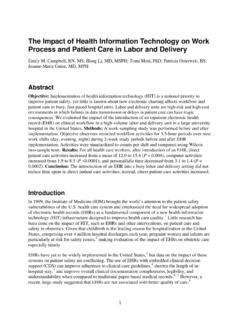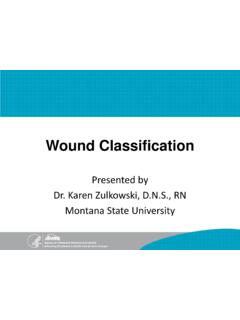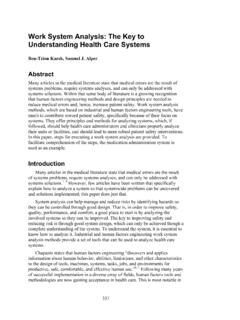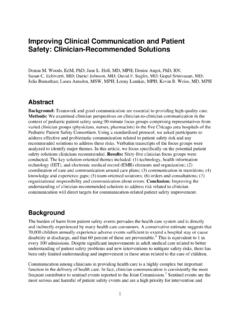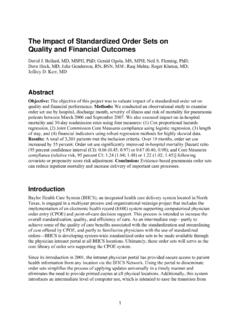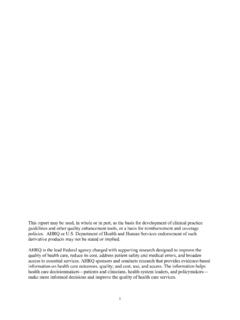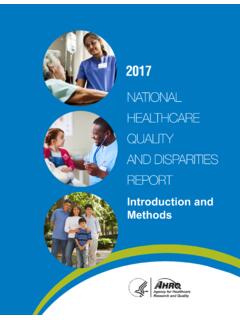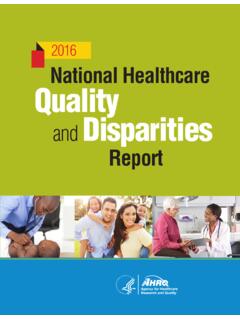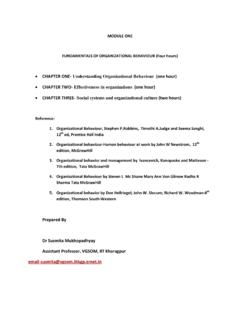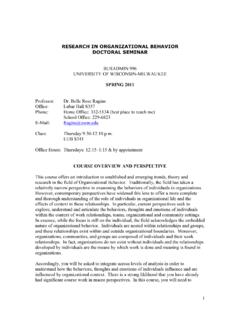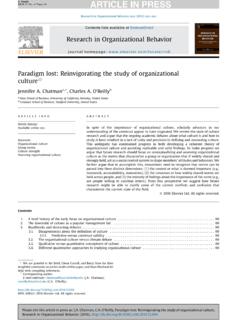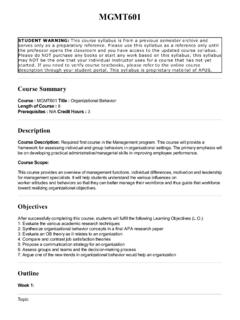Transcription of Organizational Behavior Management in Health Care ...
1 Organizational Behavior Management in Health Care: Applications for Large-Scale Improvements in Patient Safety Thomas R. Cunningham, MS, and E. Scott Geller, PhD Abstract Medical errors continue to be a major public Health issue. This paper attempts to bridge a possible disconnect between behavioral science and the Management of medical care. Epidemiologic data on patient safety and a sampling of current efforts aimed at patient safety improvement are provided to inform relevant applications of Organizational Behavior Management (OBM). The basic principles of OBM are presented, along with recent innovations in the field that are relevant to improving patient safety. Safety-related applications of Behavior -based interventions from both the behavioral and medical literature are critically reviewed.
2 Potential OBM targets in Health care settings are integrated within a framework of those OBM techniques with the greatest possibility of improving patient safety on a large scale. Introduction Organizational Behavior Management (OBM) focuses on what people do, analyzes why they do it, and then applies an evidence-based intervention strategy to improve what people do. The relevance of OBM to improving Health care is obvious. While poorly designed systems contribute to most medical errors, OBM provides a practical approach for addressing a critical component of every imperfect Health care system Behavior . Behavior is influenced by the system in which it occurs, yet it can be treated as a unique contributor to many medical errors, and certain changes in Behavior can prevent medical error.
3 This paper reviews the principles and procedures of OBM as they relate to reducing medical error and improving Health care. First, we need to define medical error. This task is neither simple nor straightforward because the definition of a medical error varies markedly across different hospitals and Health care systems. For example, the National Patient Safety Foundation1 defines a Health care error as: [A]n unintended Health care outcome caused by a defect in the delivery of care to a patient. According to the Institute of Medicine (IOM), a Health care error is a problem in the process of care itself or failure of a planned action to be completed as intended or the use of a wrong plan to achieve an aim. 2 Thus, while some refer to medical error as any act, or failure to act, which results in harm to a patient, others refer to medical error as any action within the process of care that may have the potential to cause harm.
4 This latter prevention-focused definition best fits the application of OBM. This distinction is relevant to interpreting the patient safety literature, since research results typically focus on frequencies of adverse events (outcomes) rather than process-level errors (or 1behaviors) occurring during Health care. However, a single error does not guarantee that a patient will experience a medical injury. An examination of case studies of errors presented in the Annals of Internal Medicine suggests as many as 17 separate individual errors may occur before a patient is actually Thus, process measures need to be addressed in designing patient safety programs. Dimensions of Medical Errors The Agency for Healthcare Research and Quality (AHRQ) Patient Safety Indicators4 (PSIs) are the most commonly used measures of patient safety performance.
5 They include 16 classes of patient safety incidents (Table 1). Although this is a useful classification system, prevention requires a specification of actions leading to these types of patient safety incidents. Leape5 has provided a brief and practical typology of medical errors that includes four main domains: 1. Diagnostic. 2. Treatment. 3. Preventive. 4. Other. Within these domains is a more specific list of 14 types of errors that can be seen as a hierarchy of severity (Table 1). In comparing these two methods of classification, the difference between outcome and process measurement is salient. Although various patient safety incidents could be caused by a number of factors, Leape s taxonomy reflects specific problem behaviors.
6 The most common types of preventable errors resulting in adverse events have been identified as: technical errors (44 percent); errors in diagnosis (17 percent); failures of prevention (12 percent); and errors in the use of a drug (10 percent).5 In terms of overall numbers, preventable technical complications of surgery (10,891) and wound infections (9,659) were most common, indicating areas where hospitals should focus their intervention efforts. A more recent report6 suggests that almost 60 percent of all patient safety incidents include: failure to rescue (delayed diagnosis and treatment); decubitus ulcer (bed sores); or postoperative sepsis (blood infection). This report also suggests the most lethal patient safety incidents or those most closely associated with mortality include failure to rescue and unexpected death during a low-risk hospitalization.
7 Between 1995 and 2000, an increasing trend of certain types of events suggested a need for special attention. These included postoperative medical- and nursing-related adverse events, such as respiratory failure (31 percent); infection due to medical care (14 percent); decubitus ulcer (19 percent); septicemia (41 percent); thromboembolism (42 percent); and accidental punctures and lacerations (7 percent).7 Certain signs of progress are also noteworthy. Specifically, anesthesia reactions and complications decreased by 18 percent, and foreign bodies left during procedures were reduced 2 Table 1. Two widely used taxonomies for patient-safety incidents and medical errors AHRQ PSIs Leape Typology of Errors 1. Accidental puncture or laceration Domain Error 2.
8 Complications of anesthesia 3. Death in low-mortality Diagnostic Related Groupings (DRGs) 4. Decubitus ulcer 5. Failure to rescue 6. Foreign body left during procedure 7. Iatrogenic pneumothorax Diagnostic 1. Error or delay in diagnosis 2. Failure to employ indicated tests 3. Use of outmoded tests or therapy 4. Failure to act on the results of monitoring or testing 8. Selected infections due to medical care 9. Postoperative hemorrhage or hematoma 10. Postoperative physiologic and metabolic derangement 11. Postoperative pulmonary embolism or deep vein thrombosis 12. Postoperative respiratory failure 13. Postoperative sepsis 14. Postoperative wound dehiscence 15. Transfusion reaction Treatment 5.
9 Technical error in the performance of a procedure 6. Error in administering treatment 7. Error in dose or method of use of a drug 8. Avoidable delay in treatment or in response to an abnormal test 9. Inappropriate care 16. Birth trauma and obstetric trauma (3 types related to delivery methods) Preventive 10. Failure to provide indicated prophylactic treatment 11. Inadequate treatment monitoring or followup Other 12. Failure in communication 13. Equipment failure 14. Other systems failure by 7 percent. While small, these improvements are encouraging in terms of current proactive efforts to address patient safety. Preventing Errors in Health Care As depicted in Figure 1, patient safety outcomes are influenced by a number of factors, including several sources external to the hospital ( , relevant legislation, agency mandates, and special interest groups).
10 Within-hospital sources include the Health care culture, the institutional patient safety agenda, the specific environmental context in which the Health care worker operates (which includes the patient), and the focus of this paper the Behavior of the caregiver. These multiple influences are, in turn, affected by patient safety outcomes in a reciprocal system most certainly affected by innumerable additional factors in varying degrees. 3 Figure 1. An overall model of patient safety. Domains of influence relevant to OBM are shown enlarged and in italics. Errors Addressed by System Change Medical mistakes caused by latent errors, such as similar sounding drug names or delays in treatment due to lack of staff, are best addressed by system change.


